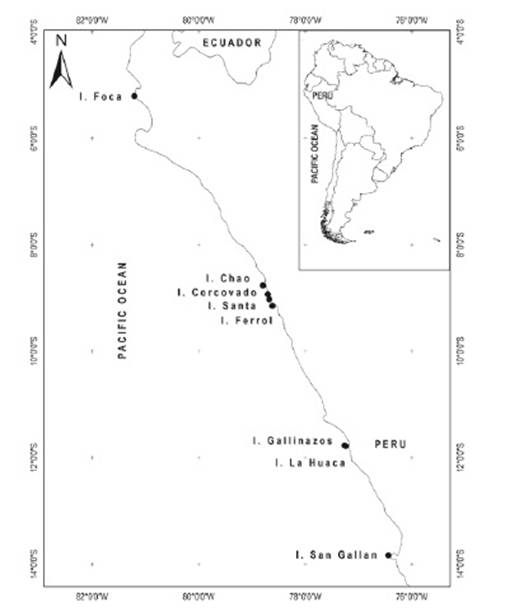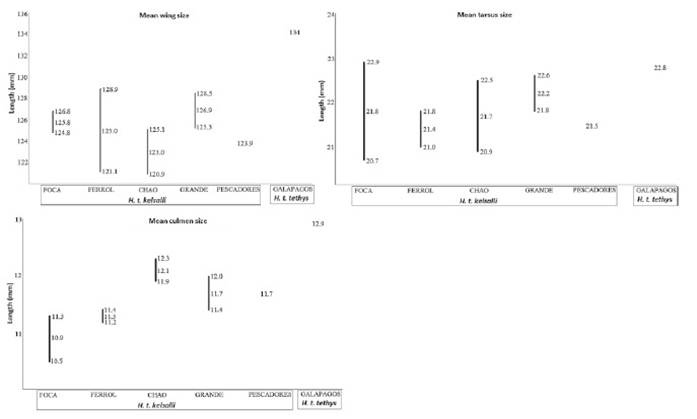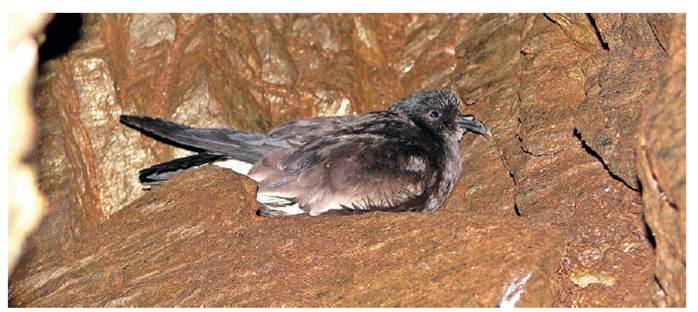Introduction
The Wedge-rumped Storm Petrel is native to the tropical eastern Pacific Ocean (Harrison 1936). Two subspecies are recognized, including Hydrobates tethys tethys, which nests in the Galapagos Islands (Murphy 1983), and Hydrobates tethys kellsalli, which breeds on islands off Peru and Chile (Murphy 1936, Ayala and Sánchez-Scagloni 2007, Bernal et al. 2006). During the non-breeding season, it ranges as far north as Mexico and California, and south to northern Chile (Carboneras et al. 2014). Hydrobates tethys kelsalli is the smaller of the subspecies, particularly with regard to wing length (Murphy 1936).
Storm petrel (Hydrobatidae) reproduction along the southeastern Pacific coast is poorly known. They usually nest on islands, building nests in burrows and crevices along cliffs and stone walls, and returning to breeding areas at night (Torres-Mura & Lemus 2013). However, in the past decades, new reproductive colonies of some species of this family (including H. t. kelsalli) have been discovered along the Peruvian and Chilean coast (Ayala & Sanchez-Scaglioni 2007, Hertel & Torres-Mura 2003, Torres-Mura & Lemus 2013, Jahncke 1993).
Colonies of H. t. kellsali were first discovered in 1913 in Pescadores and San Gallan Islands off the central coast of Peru (Murphy 1936), but there were no additional records of their reproduction for many years. Simeone et al. (2003) found this species nesting on Grande Island in northern Chile, considerably expanding the southern limit of its known breeding range. In Peru, four nesting areas have been reported for this species: in Chao and Corcovado islands off the coast of La Libertad (Ayala et al. 2004), on Ferrol Island (Ayala & Sánchez-Scaglioni 2007), and Santa Island (Ayala et al. 2008), near Chimbote, Ancash, central Peru.
In this note we systematize the records of the nesting sites of H. t. kellsali on the Peruvian coast and describe a new nesting colony on Foca Island from northern of Peru. In addition, we compare the morphometry of H. t. kelsalli adults nesting in Peru with the published morphometry of H. t. tethys nesting on the Galapagos Islands.
Methods
Foca Island (5°12’S, 81°12’W) is located in the province of Paita in Piura region, northwestern Peru. It is located approximately 800 m from the mainland, near the fishing town La Islilla, 20 km southwest of the city of Paita (Fig. 1). The island has an area of 92 ha and is located within the convergence zone of the Humboldt Current and the Equatorial Current, which favors the presence of species associated with both warm and temperate water (Novoa et al. 2010).

Figure 1 Location of know breeding colonies of Hydrobates tethys kelsalli in the islands’ system in Peru.
In two visits made in April 2006, we carried out intensive searches within the accessible caves and cliffs of the island, between 10:00 and 17:00 hrs. Nests with eggs, chicks, or at least one parent in the incubation position were considered active. With a caliper, we measured the length of wing, culmen, and tarsus of five adults of unknown sex. The mean of these metrics was compared with the means reported by Murphy (1936), Ayala et al. (2004) and Ayala et al. (2008) using the 95% confidence interval through its standard deviations with program R (R Core Team 2017).
Results and discussion
We found 28 active nests, of which 13 (46%) contained eggs and 15 (54%) contained chicks. According to the incubation period of this subspecies (Carboneras et al. 2014), the eggs and chicks found in mid-April suggests that it begins to lay eggs in mid-March, similar to the results of Ayala and Sánchez-Scaglioni (2007) on Ferrol Island. However, in Chao and Corcovado Islands (Ayala et al. 2004), the first chick was found in May, while in Chile, Bernal et al. (2006) found that egg-laying occurs at the end of December. This suggests that this subspecies could have at least two breeding seasons in a year, supported by the uniform marine productivity of the coastal upwelling system of the Humboldt Current throughout the year.
With this record, the number of known nesting sites of H. t. kelsalli rises to eight on the Peruvian coast (Table 1). However, it is likely that there are additional unexplored sites in Peru and Chile where this subspecies could nest. In Peru, numerous islands and islets have not explicitly been explored for breeding colonies of this species, although they meet the required habitat conditions for nesting. The inaccessibility of its breeding sites is beneficial for the conservation of the species, as well as the protection provided by the fact that these islets and islands are part of the System of Guano Islands, Islets and Points National Reserves of the Peruvian state.
The nests on Foca Island were found in natural cracks and crevices between rocky walls (Fig. 2), similar to what was found in Pescadores and San Gallán islands (Murphy 1936). However, Ayala et al. (2004) and Ayala and Sánchez-Scaglioni (2007) found that this subspecies will nest in human-made stone walls built at the beginning of the last century on guano islands to increase guano deposition.
Based on the 95% confidence intervals of the mean morphometry of the specimens of Foca Island and those existing for other islands of Peru (Table 2), we established that there is no evidence of differences in mean length of the wing and tarsus (Fig. 3). Mean culmen length of the specimens from Chao Island showed strong evidence of being greater than the mean length of the culmen of the specimens from the Foca and Ferrol islands (Table 2. Fig. 3). Although we cannot establish differences with the mean of the metrics of H. t. tethys of the Galapagos Islands (standard deviation is not reported in their records), it seems that the wing of this subspecies could be greater than the mean of the wing of H. t. kelsalli (Fig. 3). Regarding the culmen and tarsus, no differences could be established.
Table 2 Comparison of the means of the Wing, Culmen and Tarsus metrics of Hydrobates tethys kelsalli and Hydrobates tethys tethys on the islands where their nesting was recorded. Parentheses show 95% confidence interval.


Figure 3 Comparison between the mean of wing, tarsus and culmen size metrics of Hydrobates tethys kelsalli and Hydrobates tethys tethys.
These results contribute to the knowledge of the distribution of the reproductive colonies of this subspecies on the Peruvian coast and morphometric aspects.












 uBio
uBio 




